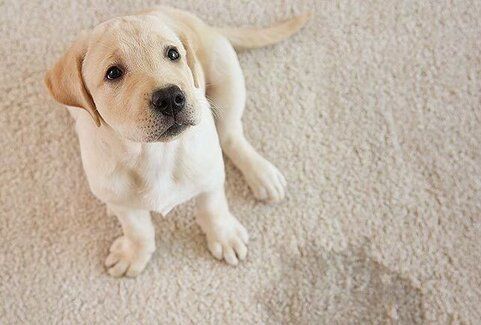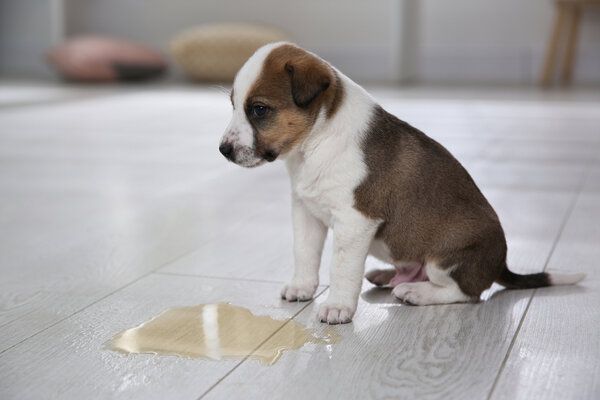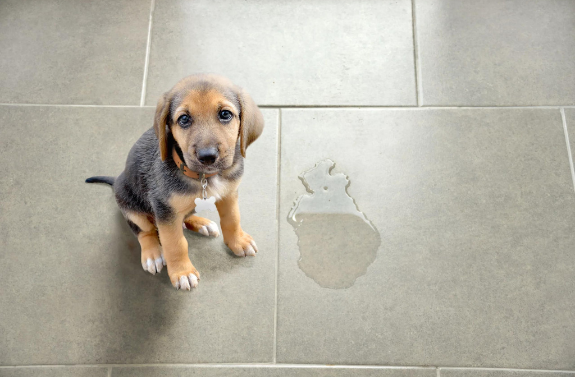A Beginner’s Guide To Dog Potty Training
Closing The Gap: Natural Instinct And Puppy Obedience
If you are reading this blog article, then you are most likely experiencing the newly found anxiety of potty training a new puppy. While the task of potty training may sound overwhelming, it is the cornerstone to a happy and rewarding bond between a dog and you, its owner. Potty training requires patience, commitment, and consistency with the process. When combined with positive reinforcement (encouragement) in form of praise and/or rewards, a puppy will typically learn proper potty habits within a few weeks and will soon be completely house trained.
You might be curious about the appropriate age to begin dog potty training and the answer to that is as soon as your puppy (or adult dog) is brought home. A puppy should not be expected to show progress until he or she is 12 to 16 weeks old. Puppies typically do not have enough control at this age. If your new dog is arriving with already learned behavior for going potty, such as in a crate or enclosed space, it will take some time and patience, as well as encouragement to reform the dog’s habits to their new space.
There are two options for where to train your dog to eliminate: outside or on a potty pad. Remember: a dog’s natural instinct is to go to the bathroom anywhere possible except where they sleep. This is why it is important to teach them obedience through positive reinforcement and repetition. Clearly defining the space they are supposed to eliminate will guide their natural instinct to a well learned behavior.
If you are choosing to designate outdoors as the appropriate spot for your puppy to eliminate, taking your new puppy outside at least every one to two hours is a good place to begin. Sticking to these intervals will help your puppy successfully learn a routine. You can then gradually increase the intervals as your puppy succeeds. If nothing happens within 10 minutes, be patient! Take your puppy back inside and try again after an additional 15 minutes. Potty time is separate from playtime until the routine becomes established, therefore it is very helpful to teach your puppy a keyword such as “time to go,” “potty time”, or “time to potty!” etc.
Speak With A Dog
Training Expert
Speak With A Dog Training Expert
Thank you for contacting us!
We will contact you shortly!
Please try again later.

Closing The Gap: Natural Instinct And Puppy Obedience
If you are reading this blog article, then you are most likely experiencing the newly found anxiety of potty training a new puppy. While the task of potty training may sound overwhelming, it is the cornerstone to a happy and rewarding bond between a dog and you, its owner. Potty training requires patience, commitment, and consistency with the process. When combined with positive reinforcement (encouragement) in form of praise and/or rewards, a puppy will typically learn proper potty habits within a few weeks and will soon be completely house trained.
You might be curious about the appropriate age to begin dog potty training and the answer to that is as soon as your puppy (or adult dog) is brought home. A puppy should not be expected to show progress until he or she is 12 to 16 weeks old. Puppies typically do not have enough control at this age. If
Speak With A Dog
Training Expert
Speak With A Dog Training Expert
Thank you for contacting us!
We will contact you shortly!
Please try again later.
your new dog is arriving with already learned behavior for going potty, such as in a crate or enclosed space, it will take some time and patience, as well as encouragement to reform the dog’s habits to their new space.
There are two options for where to train your dog to eliminate: outside or on a potty pad. Remember: a dog’s natural instinct is to go to the bathroom anywhere possible except where they sleep. This is why it is important to teach them obedience through positive reinforcement and repetition. Clearly defining the space they are supposed to eliminate will guide their natural instinct to a well learned behavior.
If you are choosing to designate outdoors as the appropriate spot for your puppy to eliminate, taking your new puppy outside at least every one to two hours is a good place to begin. Sticking to these intervals will help your puppy successfully learn a routine. You can then gradually increase the intervals as your puppy succeeds. If nothing happens within 10 minutes, be patient! Take your puppy back inside and try again after an additional 15 minutes. Potty time is separate from playtime until the routine becomes established, therefore it is very helpful to teach your puppy a keyword such as “time to go,” “potty time”, or “time to potty!” etc.



Puppy Potty Training: A Routine Matter
Puppy potty training by utilizing potty pads can be helpful for owners in various situations, including those who work away from home all day, who live in an upper floor apartment, or in a harsh climate. It is also possible the owner or dog is handicapped or incapacitated in some way. Potty pads are also a great option for owners who wish to transition their dog from eliminating inside to outside. Beginning potty pad training starts with identifying the confined area of your home in which you would like to train your dog to eliminate. Place the potty pad in this designated area. To attract your puppy or adult dog to the potty pad, place part of a previous soiled pad or old business in the center as to mark where you expect them to go. Your puppy may have trouble finding the right spot initially, and that’s okay.
Establishing a routine with your new puppy is critical. Remember, your puppy will be much easier to work with when they get into a consistent routine of knowing when to go potty, when to eat, and when their sleep periods are. As you work this timeline with your puppy, expect
Puppy Potty Training: A Routine Matter
Puppy potty training by utilizing potty pads can be helpful for owners in various situations, including those who work away from home all day, who live in an upper floor apartment, or in a harsh climate. It is also possible the owner or dog is handicapped or incapacitated in some way. Potty pads are also a great option for owners who wish to transition their dog from eliminating inside to outside. Beginning potty pad training starts with identifying the confined area of your home in which you would like to train your dog to eliminate. Place the potty pad in this designated area. To attract your puppy or adult dog to the potty pad, place part of a previous soiled pad or old business in the center as to mark where you expect them to go. Your puppy may have trouble finding the right spot initially, and that’s okay.
Establishing a routine with your new puppy is critical. Remember, your puppy will be much easier to work with when they get into a consistent routine of knowing when to go potty, when to eat, and when their sleep periods are. As you work this timeline with your puppy, expect accidents to happen. Be mindful of your reaction when this does occur, and refrain from harshly scolding or yelling at your puppy for leaving a mess. This can lead to the puppy’s distrust of you as the owner. Simply clean up the mess and relocate it to the area in which you want your puppy to eliminate. This will serve as a marker for the next time your puppy goes potty. When your dog has successfully gone potty in its designated area, praise your dog for a job well done immediately by offering a treat and verbal praise. If you catch your puppy in the process of going potty in the wrong area, carefully get your dog’s attention and move them to the appropriate spot. Once your dog finishes in that spot, praise them for a job well done.
Patience will be needed and supervision is key. Remember your outward frustration can become counterproductive, thus increasing the instruction period and leading your puppy to fear you. While puppy potty training isn’t as easy as you would like, it is well worth the effort in the long run!
accidents to happen. Be mindful of your reaction when this does occur, and refrain from harshly scolding or yelling at your puppy for leaving a mess. This can lead to the puppy’s distrust of you as the owner. Simply clean up the mess and relocate it to the area in which you want your puppy to eliminate. This will serve as a marker for the next time your puppy goes potty. When your dog has successfully gone potty in its designated area, praise your dog for a job well done immediately by offering a treat and verbal praise. If you catch your puppy in the process of going potty in the wrong area, carefully get your dog’s attention and move them to the appropriate spot. Once your dog finishes in that spot, praise them for a job well done.
Patience will be needed and supervision is key. Remember your outward frustration can become counterproductive, thus increasing the instruction period and leading your puppy to fear you. While puppy potty training isn’t as easy as you would like, it is well worth the effort in the long run!
